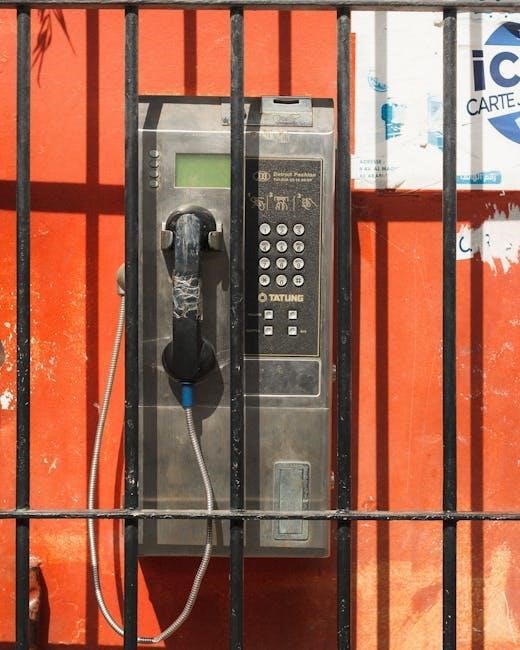Merrill Lynch wire instructions are essential for initiating secure and efficient financial transactions․ They provide a structured format, ensuring accuracy and reducing errors․ Correct details are crucial․
1․1 Overview of Merrill Lynch and Its Services
Merrill Lynch, a division of Bank of America, is a leading financial services firm offering wealth management, investment, and banking solutions․ Established in 1914, it provides tailored financial strategies to individuals, corporations, and institutions․ Services include investment advisory, retirement planning, and estate services․ Merrill Lynch emphasizes personalized advice and innovative solutions to help clients achieve financial goals․ Its expertise spans global markets, portfolio management, and risk management․ The firm integrates cutting-edge technology with a client-centric approach, ensuring secure and efficient transactions․ This foundation makes it a trusted name in financial services, particularly in wire transfers and wealth management․
1․2 Importance of Wire Instructions in Financial Transactions
Wire instructions are critical for ensuring accurate and secure financial transactions․ They provide detailed guidance for transferring funds, minimizing errors and fraud risks․ Clear instructions help verify recipient details, reducing delays or misdirected payments․ In high-stakes transactions, precise information is essential to avoid costly mistakes․ Wire instructions also streamline processes, ensuring compliance with financial regulations․ Properly executed instructions safeguard both sender and recipient, maintaining trust in the financial system․ Their importance lies in their ability to facilitate smooth, reliable, and secure transfers, making them indispensable in modern banking and wealth management․

Understanding the Wire Transfer Process
Wire transfers are secure and reliable methods for moving funds between accounts․ The process involves initiating the transfer, verifying details, and processing the transaction efficiently․
2․1 Steps to Initiate a Wire Transfer
Initiating a wire transfer involves several key steps․ First, gather all necessary recipient information, including account number and routing details․ Next, log into your Merrill Lynch account securely․ Select the wire transfer option and input the required details carefully․ Review the transaction to ensure accuracy․ Finally, confirm the transfer and retain the confirmation for records․ Proper verification ensures security and avoids delays in processing․
2․2 Key Information Required for Wire Transfers
To initiate a wire transfer, specific details are mandatory․ For domestic transfers, include the recipient’s full name, account number, and the bank’s routing number․ International transfers require the recipient’s name, account number, and the bank’s SWIFT or IBAN code․ Ensure the sender’s name and account number are accurately provided․ Additional details, such as the transfer purpose and currency type, may be required․ Verify all information for accuracy to avoid delays or errors․ Proper documentation ensures compliance with financial regulations and secures the transaction process․

2․3 Processing Times for Wire Transfers
Processing times for wire transfers vary based on the type and destination․ Domestic wire transfers typically process within 1-2 business days, often completing on the same day if initiated before the cut-off time․ International transfers may take 2-5 business days due to additional processing steps and time zones․ Delays can occur on weekends, holidays, or due to incomplete information․ Ensure transactions are initiated early to avoid delays․ Factors like intermediary banks and currency conversion may extend processing times․ Accurate details help expedite the process, ensuring funds reach the recipient promptly․ Plan accordingly to meet deadlines․

Requirements for Merrill Lynch Wire Instructions
Accurate recipient information, account details, and verification are essential․ Ensure all data is correct to avoid delays․ Compliance with Merrill Lynch’s guidelines is mandatory for secure transactions․
3․1 Necessary Information for Domestic Wire Transfers
Domestic wire transfers with Merrill Lynch require precise information to ensure seamless processing․ Key details include the recipient’s full name, account number, and ABA routing number․ The sender’s information, such as name and account number, must also be provided․ The recipient’s address is necessary to verify identity․ Using the correct ABA routing number is crucial, as errors can cause delays․ It’s important to double-check all details before initiating the transfer to avoid issues and ensure funds are delivered timely․ Accurate information helps maintain security and efficiency in domestic wire transactions․
3․2 Additional Requirements for International Wire Transfers
International wire transfers through Merrill Lynch require additional details beyond domestic transfers․ A SWIFT code or IBAN is necessary for routing funds to the recipient’s bank․ The beneficiary’s full name, account number, and address must be provided․ Currency specifications are critical, as funds are typically sent in the recipient’s local currency․ Regulatory compliance demands documentation, such as the purpose of the transfer․ The sender must also include their own information, like name and account number․ Delays or issues may arise if any details are missing or incorrect․ These requirements ensure compliance with international banking standards and facilitate smooth transactions․
3․3 Verification Processes to Ensure Security
Merrill Lynch employs robust verification processes to secure wire transfers․ Multi-layered authentication ensures only authorized users initiate transactions․ Encryption protects sensitive data during transmission․ Recipient details are cross-verified to prevent fraudulent activities․ Transactions are monitored for suspicious patterns, with alerts for unusual activity․ Two-factor authentication adds an extra security layer, ensuring only legitimate access․ These measures safeguard against unauthorized access and fraud, maintaining the integrity of financial transactions․ Regular updates to security protocols further enhance protection, ensuring compliance with industry standards and building trust in the wire transfer process․

Domestic vs․ International Wire Transfers
Domestic wire transfers involve sending funds within the same country, while international transfers cross borders, requiring additional details like SWIFT codes․ Each has distinct processing times and fees․
4․1 Differences in Requirements and Processing
Domestic wire transfers require basic recipient details like name, account number, and routing number, while international transfers need additional information such as SWIFT codes and beneficiary bank addresses․ Processing times vary significantly, with domestic transfers typically clearing the same day, whereas international transfers may take several business days due to intermediary banks․ Currency conversion is another key difference, as international transfers often involve exchange rates, adding complexity․ Documentation requirements are stricter for international transactions to comply with anti-money laundering regulations․ These differences highlight the need for careful preparation to ensure smooth and efficient fund transfers, whether domestic or international․
4․2 Fees Associated with Domestic and International Transfers
Fees for wire transfers vary between domestic and international transactions․ Domestic transfers typically incur a lower fee, often ranging from $10 to $30, depending on the bank and account type․ International transfers are more costly, usually between $40 to $50, due to additional processing requirements and intermediary banks․ Some banks may also charge a receiving fee․ Currency conversion for international transfers can add to the total cost, with exchange rate margins applied․ It’s important to review Merrill Lynch’s fee schedule to understand the exact charges for your specific transaction type and ensure accurate budgeting for your wire transfers․
4․3 Currency Conversion for International Transfers
Currency conversion is a key aspect of international wire transfers, impacting the final amount received․ Exchange rates fluctuate based on global markets, and Merrill Lynch applies a margin to these rates․ This can increase transfer costs․ Recipients should be aware of potential fees from their banks for receiving foreign currency․ To minimize costs, verify current exchange rates before initiating a transfer․ Additionally, consider using tools or consulting with financial specialists to optimize currency conversion and reduce additional charges․ Ensuring clarity on conversion rates and fees helps in making informed decisions for efficient international transactions;

Security Measures for Wire Transfers
Merrill Lynch employs robust security measures, including encryption and secure platforms, to protect wire transfers․ Advanced fraud monitoring ensures transactions are safe and reliable․
5․1 Protecting Against Fraudulent Activities
Protecting against fraudulent activities is a top priority for Merrill Lynch wire transfers․ The platform uses advanced encryption and multi-layered security systems to safeguard transactions․ Verification processes, such as two-factor authentication, ensure only authorized individuals can initiate transfers․ Customers are advised to verify recipient details thoroughly before sending funds․ Monitoring account activity regularly and reporting suspicious transactions promptly helps prevent fraud․ Merrill Lynch also employs fraud detection algorithms to identify unusual patterns and block potentially fraudulent transfers․ By combining robust technology with user vigilance, the risk of fraudulent activities is significantly minimized, ensuring secure and reliable financial transactions․
5․2 Encryption and Secure Platforms for Transactions
Merrill Lynch employs state-of-the-art encryption technologies to ensure transactions are conducted securely․ All wire transfers are processed through encrypted platforms, protecting sensitive information from unauthorized access․ Secure Sockets Layer (SSL) encryption is used to safeguard data transmission between clients and servers․ Additionally, the platform adheres to strict industry standards for data protection, ensuring compliance with regulations․ Two-factor authentication adds an extra layer of security, verifying user identities before allowing transactions․ These measures create a robust security framework, giving clients confidence in the integrity and safety of their financial transactions․ Merrill Lynch’s commitment to encryption and secure platforms minimizes risks associated with online transactions․
5․3 Best Practices for Maintaining Transaction Security
To maintain transaction security, Merrill Lynch recommends verifying recipient details before initiating transfers․ Use strong, unique passwords and enable two-factor authentication for added protection․ Regularly monitor account activity for suspicious transactions and report discrepancies promptly․ Avoid using public computers or unsecured networks for transactions․ Keep software and browsers updated to protect against vulnerabilities․ Additionally, educate yourself on phishing scams and never share sensitive information via email or unverified links․ By following these best practices, clients can significantly reduce the risk of fraudulent activities and ensure secure wire transfers․ Vigilance and proactive measures are key to safeguarding financial transactions․

Common Mistakes to Avoid
Common mistakes include entering incorrect recipient details, typos in wire instructions, and insufficient funds․ Always verify information and check transfer limits to prevent delays or failures․
6․1 Incorrect or Incomplete Recipient Information
One of the most common mistakes is providing incorrect or incomplete recipient details․ This can lead to delayed or failed transactions․ Always double-check the recipient’s full name, account number, and routing information․ Ensure the beneficiary’s address and bank details are accurate to avoid misdirection of funds․ Small typos, such as incorrect ZIP codes or misspelled names, can cause significant issues․ Verify the information with the recipient before initiating the transfer․ Incomplete details may result in the transaction being rejected or placed on hold, requiring additional time and effort to resolve․
6․2 Insufficient Funds or Transfer Limits
Insufficient funds or exceeding transfer limits can halt wire transactions․ Ensure your account balance covers the transfer amount, including fees․ Verify daily or monthly transfer caps set by Merrill Lynch or your bank․ Exceeding these limits may result in delayed processing or outright rejection․ Additionally, some accounts have maximum transfer limits for security reasons․ Always review your account balance and transfer restrictions before initiating a wire transfer․ If funds are insufficient, the transaction will fail, potentially incurring additional fees․ Be aware of these limits to avoid unnecessary delays or financial penalties․ Proper planning ensures smooth and efficient fund transfers․ Always confirm your account balance and transfer limits beforehand․
6․3 Delayed or Failed Transactions
Delayed or failed transactions can occur due to incorrect recipient details, bank processing issues, or system errors․ Verify all information before initiating the transfer․ If a transaction fails, contact Merrill Lynch support immediately to resolve the issue․ Delays often happen due to weekends, holidays, or high volumes of transactions․ International transfers may take longer due to additional processing steps․ Monitor your account for updates and consider resubmitting the transfer if it fails․ Keep records of transaction attempts for reference․ Addressing delays promptly ensures funds reach their destination efficiently․ Always double-check details to avoid repeated issues and potential fees․ Stay proactive to minimize disruptions․

Troubleshooting Wire Transfer Issues
Identify issues by reviewing transaction details, contacting Merrill Lynch support for assistance, and monitoring transfer status to resolve problems effectively and ensure timely resolution of any discrepancies․
7․1 Resolving Incorrect Transaction Details
Incorrect transaction details can delay or fail wire transfers․ To resolve this, double-check the recipient’s account number, routing information, and name for accuracy․ If an error is detected, contact Merrill Lynch support immediately to correct the details before processing․ Delays may result in failed transfers or reversed funds․ Ensure all information matches the recipient’s account records to avoid discrepancies․ Maintaining clear communication with the recipient and keeping detailed records can help resolve issues promptly․ Regularly reviewing transaction history and using Merrill Lynch’s online platform tools can also prevent errors and ensure smooth processing of wire transfers․
7․2 Addressing Transfer Delays or Failures
Transfer delays or failures can occur due to incorrect details, connectivity issues, or bank processing times․ If a delay happens, contact Merrill Lynch support to identify the cause․ Provide any requested documentation to resolve the issue promptly․ If a transfer fails, verify the recipient’s information and resubmit the request with corrected details․ Monitoring the transaction status through Merrill Lynch’s online platform can help track progress․ Keeping detailed records of communication and steps taken ensures transparency․ Addressing delays early minimizes disruption and helps recover funds quickly if needed․
7․3 Contacting Merrill Lynch Support
For assistance with wire transfers, contacting Merrill Lynch support is essential․ Reach them via phone, online chat, or secure messaging through their platform․ Provide details like transaction IDs or account numbers for quick resolution․ Support agents can address delays, failed transfers, or clarify instructions․ Ensure accurate information to expedite solutions․ Merrill Lynch support is available to guide users through complex processes, ensuring smooth transactions and resolving issues promptly․ Their expertise helps in navigating wire transfer challenges effectively, maintaining the security and efficiency of financial operations․

Best Practices for Using Merrill Lynch Wire Instructions
Always verify recipient details, monitor transaction status, and use secure platforms․ Double-check instructions to avoid errors and ensure timely processing of wire transfers․
8;1 Double-Checking Transaction Details

Double-checking transaction details is crucial to ensure accuracy․ Verify recipient names, account numbers, and routing information to prevent errors․ Use secure platforms and encryption for protection․ Monitor transactions regularly to avoid delays․ Keep detailed records for future reference․ This practice minimizes risks and ensures smooth processing․ Always review instructions before submission to avoid costly mistakes․ Correct details are essential for efficient wire transfers․ Double-checking helps maintain security and accuracy, ensuring funds reach the intended recipient without issues․ Regular monitoring and record-keeping are key to efficient and secure transactions․
8․2 Monitoring Transaction Status
Monitoring transaction status ensures transparency and control․ Use Merrill Lynch’s online platform or mobile app for real-time updates․ Track progress from initiation to completion․ Set up notifications for status changes․ Regularly check your account for confirmations․ This helps identify delays early and resolve issues promptly․ Monitoring ensures transactions are processed smoothly and securely․ Stay informed about transfer progress to maintain peace of mind․ Regular checks prevent overlooked details and ensure timely completion․ Keep track of your transactions to avoid delays and ensure funds are delivered as intended․ Monitoring is a key step in managing wire transfers efficiently․
8․3 Keeping Records of Transactions
Maintaining detailed records of wire transfers is crucial for organization and reference․ Keep copies of transaction confirmations, including dates, amounts, and recipient details․ Store records securely, both digitally and physically․ Regularly review and update your records to ensure accuracy․ This helps in tracking financial activities and complying with regulatory requirements․ Organized records also aid in resolving disputes or discrepancies; Secure your documents to prevent unauthorized access․ Accurate and accessible records ensure smooth audits and financial planning․ By keeping thorough records, you maintain transparency and control over your transactions, ensuring accountability and peace of mind․
Merrill Lynch wire instructions streamline secure financial transactions, ensuring efficiency and accuracy․ By adhering to these guidelines, individuals and institutions can confidently manage their funds with minimal errors․
9․1 Summary of Key Points
Merrill Lynch wire instructions are a critical tool for secure and efficient financial transactions․ They ensure accuracy and compliance with regulatory standards․ Key details, such as recipient information and transfer amounts, must be precise to avoid delays․ Domestic and international transfers have distinct requirements, including currency conversion for global transactions․ Verification processes enhance security, protecting against fraudulent activities․ Understanding these elements is vital for seamless transactions․ Adhering to Merrill Lynch’s guidelines ensures compliance and reduces errors․ Proper execution of wire instructions fosters trust and reliability in financial operations, making them indispensable for individuals and institutions alike․
9․2 Final Tips for Efficient Wire Transfers
To ensure efficient wire transfers, always double-check recipient details and transfer amounts before initiating․ Verify account balances and transfer limits to avoid delays․ For international transfers, confirm currency conversion rates and associated fees․ Maintain clear records of transactions for future reference․ Monitor transfer status through Merrill Lynch’s online platform or mobile app․ Address any discrepancies promptly by contacting customer support․ Regularly review account activity to detect unauthorized transactions․ By following these tips, you can streamline your wire transfer process, minimize errors, and enhance overall financial security․ Consistency and attention to detail are key to achieving seamless transactions․
